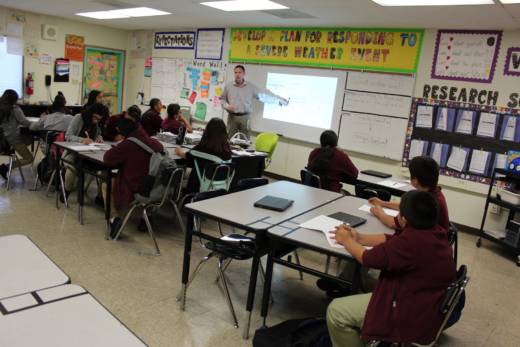But unlike Senate Bill 126, which Newsom signed Tuesday, and which received little opposition from charter school advocates, the forthcoming proposals can expect vigorous and organized pushback.
“These are the policy equivalent of an extended middle finger,” said Eric Premack, executive director and founder of the Sacramento-based Charter Schools Development Center. “This is not the type of legislation that is designed to engender constructive discussion.”
Teachers unions, however, are welcoming the legislation with open arms.
“It’s been a long time coming,” Alex Caputo-Pearl, president of United Teachers Los Angeles, said of the proposed bills, which he called “common-sense regulations.”
“The massive community support that was seen in both the L.A. and Oakland teachers’ strikes showed that parents and communities and the public are willing to fight for the sustainability of public schools,” Caputo-Pearl added. The “most important” bill of the bunch, he said, would place caps on the number of new charter schools that can be created.
Newsom was noncommittal about the upcoming charter proposals at a Tuesday signing ceremony for SB 126. But the governor also said that he was “exhausted” by the intense, polarizing debates surrounding the role of charter schools in California and was “hopeful, but not naive” about the prospects for consensus.
“I want to make sure that I’m a conduit to a package that can be broadly supported,” he said. “The goal over the next few months is to work to address a number of these vexing issues that frankly need to be addressed. It’s long overdue to have these conversations.”
The governor emphasized that he’s already asked state Superintendent of Public Instruction Tony Thurmond to commission a report studying the financial impact of charter school growth on districts’ budgets.
But some lawmakers signaled they might not be willing to wait for the completion of Thurmond’s study, which is expected to be presented in July.
Assemblyman Patrick O’Donnell, a Democrat from Long Beach and chair of the Assembly Education Committee, is part of the group of legislators pushing for further regulations on charters. O’Donnell said he would consider the Thurmond-led panel’s recommendations, but did not plan to wait for the report’s completion to advance the bills.
“I’m not going to kick the can down the road, which has been done so many times in Sacramento, and wait and hope that some committee that someone has put together comes up with wise recommendations. I’m going to act,” O’Donnell told CALmatters. “This is the year where I’ve seen the largest push and the most fervor and a sense of urgency (to address this issue).”
Assemblyman Kevin Kiley of Rocklin, the education committee vice chair and sole Republican, said the proposed bills are “all very bad ideas – each and every one.”
“This is just fundamentally an issue of educational equity,” Kiley said. “And I think the debate over these bills is going to be a chance to see who in the Legislature cares about providing every child in California access to a great education and who has other priorities.”
The new political landscape follows a prolong period during which California’s powerful teachers unions and the charter school movement often fought for influence in Sacramento as charter enrollment exploded throughout the state. The charter school movement often found support from moderate Democrats, Republicans and Brown, who started two charter schools when he was mayor of Oakland; teachers unions, meanwhile, have largely counted on the support of progressive Democrats, who have more consistently defended traditional public schools.
The 2018 elections, however, upended part of that political calculus. Unions and billionaire school reform advocates pumped tens of millions of dollars into the primary and general election campaigns, with Newsom and Thurmond—labor-backed candidates—emerging as the victors.
High-profile teacher strikes, both nationally and in California, have further inflamed the debate over charters, which advocates have typically presented as an antidote to low-performing public schools in low-income areas, and unions have framed as a drain on funding and resources for traditional public schools.
John Rogers, professor of education at UCLA, said the 2018 election “sent a signal to Democratic legislators that there is a change afoot in the way the broader public, in particular Democratic voters, are thinking about charters.”
The two deals that resolved the strikes in Los Angeles and Oakland included commitments from both local school boards to consider enacting a moratorium on the growth of charter schools while their budget impacts could be more carefully scrutinized.
Soon after the Los Angeles Unified school board passed its resolution, Newsom asked Thurmond to lead a panel, despite concerns among charter advocates that the strike rhetoric unfairly scapegoated charters. Both districts have seen a huge growth in charter schools in the last 20 years, although their financial turmoil stems from numerous factors, including rising employee pension and health care costs and declining enrollment.
Myrna Castrejón, president and CEO of the California Charter Schools Association, joined Newsom in his bill-signing ceremony Tuesday. Though the association took a neutral stance on SB 126, Castrejón called the legislation “a balanced and comprehensive resolution” and touted Newsom’s leadership.
Castrejón said the proposed charter regulation bills soon to be debated were “terrible policy,” but expressed hope that Newsom could guide those conversations toward consensus.
“With the leadership of our new governor and partners willing to come to the table and have serious conversations and solve serious problems, we’re hopeful that that spirit can carry us through to a better conversation about this package of bills that in the end would damage California’s students,” Castrejón said.

